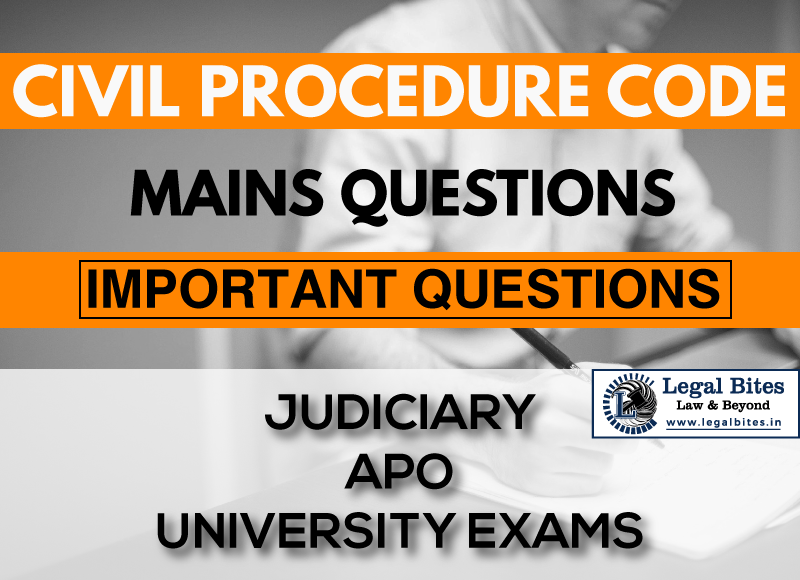CPC Mains Questions Series Part VII: Important Questions for Judiciary, APO & University Exams | Part – VII of X
Legal Bites brings to you CPC Mains Questions Series Part VII.

Legal Bites brings to you CPC Mains Questions Series Part VII. The questions enlisted here are arranged section-wise and will aid the students in preparing for Judiciary, APO or University Exams. The list of questions curated by Legal Bites will help candidates identify the important and frequently asked questions and give them good practice for their aptitude and knowledge.
CPC Mains Questions Series Part VII
We know answer writing is a continuous exercise that is an inalienable part of the preparation process for any Examination. A well-written answer not only reflects the knowledge of an aspirant but also his/her ability to tailor the content in a manner suited to meet the expectations of the question.
Rigorous preparation for this exam is mandatory in order to crack it. In the last few months prior to the exams, it is sufficient for candidates to simply keep practising these questions in order to gain mastery over the subjects studied. Not only the candidate’s confidence level but also their scores will show good improvement upon following it.
CPC Mains Questions Series Part VII of X
Question 1
Explain the term “Non-joinder or Misjoinder of Parties”. [Raj. J.S. 1969, UPCJ, 2018]
Question 2
Question 3
- What do you understand by splitting of claim? Can a fresh suit for sale on the basis of a mortgage be filed, if a suit for personal decree was already filed and was decreed?
- What claims can be joined for recovery of immovable property?
Question 4
Question 5
Question 6
Question 7
Question 8
When a summons issued by the Court to the defendant and in what various manners can such summons be served? [UPCJ 1984, 1985] Or What are the particulars of summons? Describe the different modes of service of summons. [UPCJ 2015]
Question 9
What is substituted service? When can it be ordered and how can be effected? Discuss with reference to the provisions of the Code of Civil Procedure, 1908. Or What do you mean by Substituted service? [UPHJS 2018]
Question 10
Describe the fundamental rules of pleadings? Discuss them in detail.
Question 11
Question 12
Question 13
Question 14
Describe the particulars of the plaint.
Question 15
Discuss the grounds of return of a plaint to the plaintiff or of its rejection. Can a plaintiff institute a fresh suit on the same cause of action on the rejection of plaint?
Question 16
Question 17
Does the Code of Civil Procedure, 1908 empower the Court to reject a plaint? If so, under what circumstances? [U.P.C.J. 2018]
Question 18
Question 19
The plaintiff instituted a suit for recovery of money. It is the case of the plaintiff that he had purchased certain land from the defendant; the said land acquired by the Government and accordingly he applied for compensation; however, the defendant objected to the release of compensation to the plaintiff owing where to the release of compensation to the plaintiff was delayed by several years.
The defendant however subsequently withdrew his objections and where after the compensation was released to the plaintiff. The suit is filed for recovery of compensation for delay caused by the defendant in the release of land acquisition compensation. The defendant contested the suit by denying the sale of land to the plaintiff and further pleaded that the objections to release of compensation was withdrawn by him on the basis of a compromise in writing arrived at between the parties but the plaintiff mischievously obtained his signatures on an unconditional application for withdrawal of objection also.
The defendant however did not file the compromise in writing along with the written statement. However, during the cross-examination of the plaintiff, the defendant put to him the said compromise in writing. The plaintiff denied his signature on the same. The defendant thereafter in his own evidence sought to prove the said compromise in writing. The plaintiff objected to the same contending that the defendant has not filed the document at the appropriate stage could not prove the same. Decide the said objection of the plaintiff.
Question 20
What do you mean by set-off? Explain the difference between legal set-off and equitable set-off.
Question 21
Question 22
‘A sues ’13’ on a bill of exchange for Rs. 10,000. ‘B’ holds a judgment against 'A for Rs. 15,000. ’13’ claims set-off against 'A for 15,000. Will ’13 succeed? Give reasons and also refer to relevant provisions in this regard.
Question 23
‘A’ sues on a bill of exchange. '13″ alleges that ‘A’ has wrongfully neglected to insure B’s goods and is liable to him in compensation which he claims to set off. Will '13 succeed – his claim of set-off? Give reasons. [U.P.C.J. 2006]
Question 24
Question 25
Sushmita sues Abhishek for compensation on account of trespass. Abhishek holds a promissory note for Rs. 10,000 from Sushmita and claims to set off that amount against any sum that Sushmita may recover in the suit. Will Abhishek succeed in his claim of set-off against Sushmita? Give reasons.
Question 26
Gopal and Nehal sue Amar for Rs. 10,000. Amar claims set off for a debt of Rs. 5,000 due to him alone by Gopal. Will Amar succeed in his claim of set-off? Give reasons. [Bihar H.J.S. 1990]
Question 27
‘A’ dies intestate and in debt to 'B. ‘C takes out administration to A’s effects and ’13 buys part of the effects from ‘C. In a suit for purchase money by ‘C’ against ‘B’, the latter wants to set off the debt. Answer with reasons. [U.P.C.J. 2006]
Question 28
What do you mean by counter-claim? Give the difference between counterclaims and set-off.
Question 29
Question 30
What do you mean by an exparte decree? State the procedure for setting aside an ex-parte decree.
